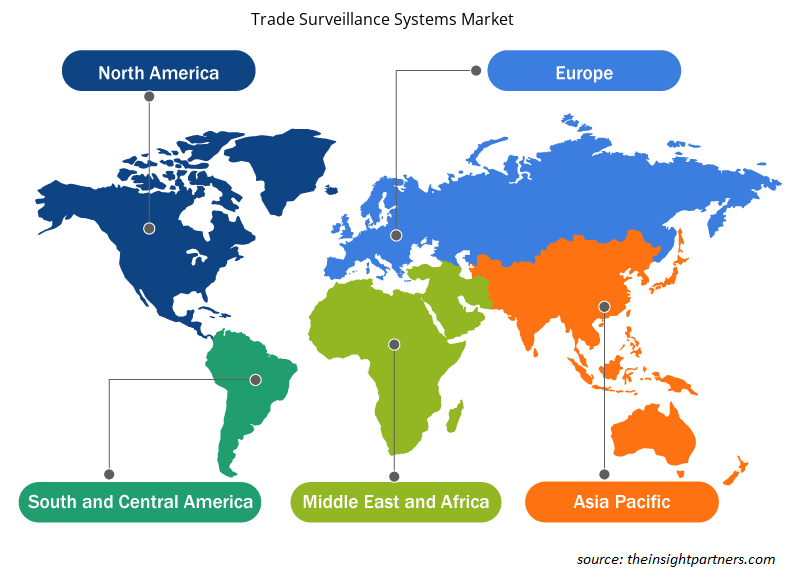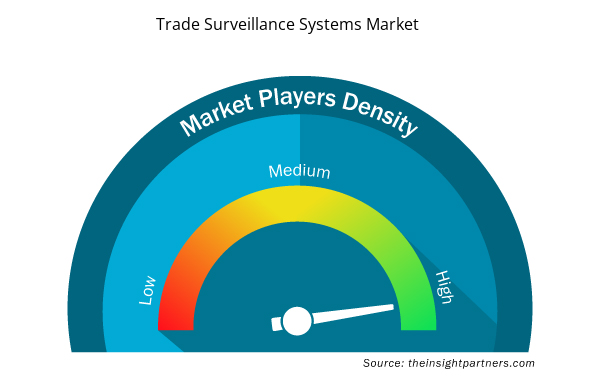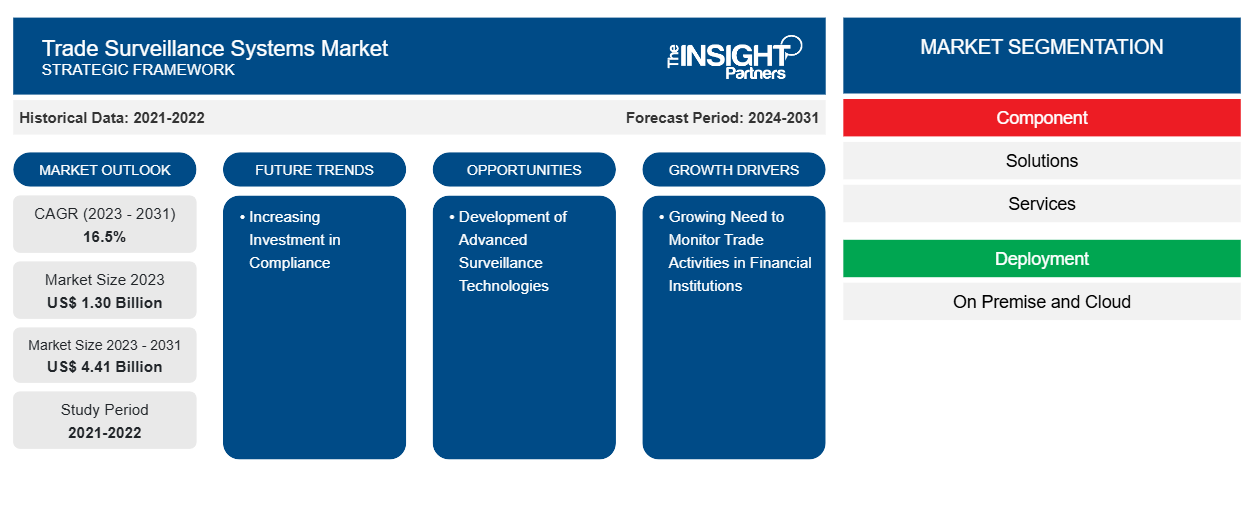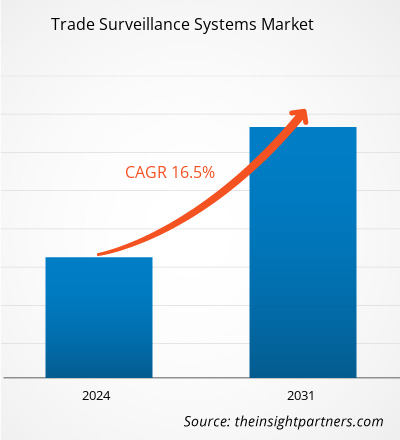من المتوقع أن يصل حجم سوق أنظمة مراقبة التجارة إلى 4.41 مليار دولار أمريكي بحلول عام 2031 من 1.30 مليار دولار أمريكي في عام 2023. ومن المتوقع أن يسجل السوق معدل نمو سنوي مركب بنسبة 16.5٪ خلال الفترة 2023-2031. ومن المرجح أن يظل الاستثمار المتزايد في الامتثال اتجاهًا رئيسيًا في السوق.
تحليل سوق أنظمة مراقبة التجارة
إن سوق أنظمة مراقبة التجارة ينمو ويتطور بسرعة، مدفوعًا بعوامل مختلفة ويقدم مجموعة من الفرص. ومن أكبر الفرص التي يمكن أن تغتنمها أنظمة مراقبة التجارة هي تقنيات المراقبة المتقدمة، مثل التعرف على الأنماط القائمة على الذكاء الاصطناعي وخوارزميات التعلم الآلي. تساعد تقنيات الذكاء الاصطناعي اليوم المؤسسات المالية على تحليل كميات هائلة من بيانات التداول في الوقت الفعلي وتحديد أنماط التداول المشبوهة بسهولة والحالات المحتملة لإساءة استخدام السوق. كما سيفيد السوق من خلال النمو في أهمية حلول المراقبة الشاملة مع الأسواق المتكاملة ومراقبة الاتصالات، إلى جانب فرض القوانين واللوائح على المؤسسات المالية لتحسين أمن وخصوصية المنظمة.
نظرة عامة على سوق أنظمة مراقبة التجارة
أنظمة مراقبة التداول هي حلول تكنولوجية كاملة النطاق تستخدمها المؤسسات المالية والهيئات التنظيمية لمراقبة وكشف ومنع إساءة استخدام السوق والتداول من الداخل وغير ذلك من سوء السلوك داخل الأسواق المالية. تستخدم مثل هذه الأنظمة تقنيات متقدمة مثل الذكاء الاصطناعي والتعلم الآلي وتحليلات البيانات الضخمة لمسح كميات كبيرة من بيانات التداول في الوقت الفعلي بحثًا عن أنماط التداول غير النظامية والانتهاكات المحتملة للوائح والأنشطة المشبوهة الأخرى. هذه أنظمة متطورة تعتمد على الخوارزميات تمكن المؤسسات من اكتشاف أي انتهاكات محتملة للامتثال مسبقًا واتخاذ التدابير اللازمة للحفاظ على نزاهة السوق ونزاهة ممارسات التداول ومعايير اللوائح. إلى جانب ذلك، تساهم أنظمة مراقبة التداول في الأسواق المالية بشكل كبير جدًا من خلال تعزيز ثقة المستثمرين وتحقيق الشفافية من أجل خلق بيئة آمنة وأخلاقية للتداول.
قم بتخصيص هذا التقرير ليناسب متطلباتك
ستحصل على تخصيص لأي تقرير - مجانًا - بما في ذلك أجزاء من هذا التقرير، أو تحليل على مستوى الدولة، وحزمة بيانات Excel، بالإضافة إلى الاستفادة من العروض والخصومات الرائعة للشركات الناشئة والجامعات
- احصل على أهم اتجاهات السوق الرئيسية لهذا التقرير.ستتضمن هذه العينة المجانية تحليلاً للبيانات، بدءًا من اتجاهات السوق وحتى التقديرات والتوقعات.
محركات وفرص سوق أنظمة مراقبة التجارة
الحاجة المتزايدة لمراقبة الأنشطة التجارية في المؤسسات المالية
إن أحد المحركات الرئيسية لسوق أنظمة مراقبة التجارة هو الحاجة المتزايدة لمراقبة الأنشطة التجارية في المؤسسات المالية. ويمكن إرجاع جذور هذا المطلب إلى عوامل مختلفة تؤكد على دور المراقبة التجارية الفعالة في القطاعات المالية. وفي هذا الصدد، يضع المنظمون الماليون في مختلف أنحاء العالم المزيد من التركيز على مراقبة التجارة كأحد التدابير للكشف عن الاحتيال المالي والتداول من الداخل والتلاعب بالسوق وردعه. وفي هذا المشهد التنظيمي الصارم، ظهرت حلول المراقبة المتقدمة لمساعدة الشركات الخاضعة للتنظيم على الامتثال للمتطلبات التنظيمية الجديدة. على سبيل المثال، تقدم شركة Nasdaq, Inc. منتج مراقبة السوق المسمى SMARTS والذي يساعد وكالات تنظيم البورصة الفردية والوسطاء في مراقبة الأنشطة التجارية عبر أسواق متعددة وفئات أصول. ولدى مجموعة CME فريق مراقبة السوق داخل بورصتها والذي يحدد ويراقب ويراجع مواقف ومعاملات المتداولين. يساعد موفرو الطرف الثالث لمنصات البرمجيات والتحليلات، مثل IBM مع Surveillance Insight for Financial Services وThomson Reuters مع Accelus Market Surveillance، والآن Connected Risk من Refinitiv، في التخصيص وإعداد قدرات المراقبة الشاملة للبورصات الكبرى الأخرى مثل NYSE Euronext
تطوير تقنيات المراقبة المتقدمة
إن تكنولوجيات المراقبة المتقدمة، بما في ذلك التعرف على الأنماط القائمة على الذكاء الاصطناعي وخوارزميات التعلم الآلي، تفتح فرصاً هائلة لسوق أنظمة مراقبة التداول. فهذه التكنولوجيات المتقدمة قادرة على تحليل كميات هائلة من بيانات التداول في الوقت الفعلي وتسمح للمؤسسات المالية باكتشاف أنماط التداول المشبوهة والحالات المحتملة لإساءة استخدام السوق بشكل فعال. ومع ذلك، فإن التكاليف المرتفعة للتنفيذ يمكن أن تكون عقبة كبيرة، وخاصة بالنسبة للمؤسسات المالية الأصغر حجماً. على سبيل المثال، تكون تكلفة إنشاء نظام مراقبة تداول متطور باهظة التكلفة بشكل مفرط بحيث يصعب على أي شركة وساطة صغيرة تحمل الاستثمار الأولي اللازم لمعالجة قضايا الامتثال التنظيمي وسلامة السوق بكفاءة كما تفعل الشركات الأكبر حجماً. وهذا يخلق تبايناً في السوق، حيث تتمتع المؤسسات الأكبر حجماً والأكثر قوة مالياً بفرص أفضل لاستخدام تكنولوجيات المراقبة المتطورة. وفي الوقت نفسه، تتخلف أقرانها الأصغر حجماً بسبب عدم القدرة على تحمل مثل هذه النفقات.
تقرير تحليلي لتجزئة سوق أنظمة مراقبة التجارة
إن القطاعات الرئيسية التي ساهمت في استخلاص تحليل سوق أنظمة مراقبة التجارة هي المكون والنشر وحجم المنظمة.
- بناءً على المكون، ينقسم السوق إلى حلول وخدمات. احتل قطاع الحلول حصة سوقية كبيرة في عام 2023.
- من حيث النشر، تم تقسيم السوق إلى محلي وسحابي. احتل قطاع المحلي حصة سوقية كبيرة في عام 2023.
- بناءً على حجم المنظمة، ينقسم السوق إلى الشركات الصغيرة والمتوسطة الحجم والشركات الكبيرة. احتلت شريحة الشركات الكبيرة حصة سوقية كبيرة في عام 2023.
تحليل حصة سوق أنظمة مراقبة التجارة حسب المنطقة الجغرافية
ينقسم النطاق الجغرافي لتقرير سوق أنظمة مراقبة التجارة بشكل أساسي إلى خمس مناطق: أمريكا الشمالية، ومنطقة آسيا والمحيط الهادئ، وأوروبا، والشرق الأوسط وأفريقيا، وأمريكا الجنوبية والوسطى.
يُظهِر سوق أنظمة مراقبة التجارة اختلافات وفرصًا إقليمية كبيرة. ومن المتوقع أن تحتل أمريكا الشمالية مكانة مهمة في السوق، مدفوعة بخدمات تجارية راسخة ومخاطر عالية من الاحتيال والتلاعب. من الأهمية بمكان إنشاء أنظمة مراقبة تجارية قوية. بالإضافة إلى ذلك، فإن اعتماد المنطقة العالي لأنظمة المراقبة المستندة إلى السحابة واللوائح الحكومية الصارمة يزيد من نمو السوق.
رؤى إقليمية حول سوق أنظمة مراقبة التجارة
لقد قام المحللون في Insight Partners بشرح الاتجاهات والعوامل الإقليمية المؤثرة على سوق أنظمة مراقبة التجارة طوال فترة التوقعات بشكل شامل. يناقش هذا القسم أيضًا قطاعات سوق أنظمة مراقبة التجارة والجغرافيا في جميع أنحاء أمريكا الشمالية وأوروبا ومنطقة آسيا والمحيط الهادئ والشرق الأوسط وأفريقيا وأمريكا الجنوبية والوسطى.

- احصل على البيانات الإقليمية المحددة لسوق أنظمة مراقبة التجارة
نطاق تقرير سوق أنظمة مراقبة التجارة
| سمة التقرير | تفاصيل |
|---|---|
| حجم السوق في عام 2023 | 1.30 مليار دولار أمريكي |
| حجم السوق بحلول عام 2031 | 4.41 مليار دولار أمريكي |
| معدل النمو السنوي المركب العالمي (2023 - 2031) | 16.5% |
| البيانات التاريخية | 2021-2022 |
| فترة التنبؤ | 2024-2031 |
| القطاعات المغطاة | حسب المكون
|
| المناطق والدول المغطاة | أمريكا الشمالية
|
| قادة السوق وملفات تعريف الشركات الرئيسية |
|
كثافة اللاعبين في سوق أنظمة مراقبة التجارة: فهم تأثيرها على ديناميكيات الأعمال
يشهد سوق أنظمة مراقبة التجارة نموًا سريعًا، مدفوعًا بالطلب المتزايد من المستخدم النهائي بسبب عوامل مثل تفضيلات المستهلكين المتطورة والتقدم التكنولوجي والوعي المتزايد بفوائد المنتج. ومع ارتفاع الطلب، تعمل الشركات على توسيع عروضها والابتكار لتلبية احتياجات المستهلكين والاستفادة من الاتجاهات الناشئة، مما يؤدي إلى زيادة نمو السوق.
تشير كثافة اللاعبين في السوق إلى توزيع الشركات أو المؤسسات العاملة في سوق أو صناعة معينة. وهي تشير إلى عدد المنافسين (اللاعبين في السوق) الموجودين في مساحة سوق معينة نسبة إلى حجمها أو قيمتها السوقية الإجمالية.
الشركات الرئيسية العاملة في سوق أنظمة مراقبة التجارة هي:
- مجموعة ACA
- بورصة أكويس
- ب-التالي
- شركة كريسيل المحدودة
- FIS العالمية
- ناسداك المحدودة
إخلاء المسؤولية : الشركات المذكورة أعلاه ليست مرتبة بأي ترتيب معين.

- احصل على نظرة عامة على أهم اللاعبين الرئيسيين في سوق أنظمة مراقبة التجارة
أخبار السوق والتطورات الأخيرة في أنظمة مراقبة التجارة
يتم تقييم سوق أنظمة مراقبة التجارة من خلال جمع البيانات النوعية والكمية بعد البحث الأولي والثانوي، والتي تتضمن منشورات الشركات المهمة وبيانات الجمعيات وقواعد البيانات. فيما يلي بعض التطورات في سوق أنظمة مراقبة التجارة:
- أعلنت شركة ION، المزود العالمي لحلول التداول والتحليلات والخزانة وإدارة المخاطر لأسواق رأس المال والسلع وإدارة الخزانة، أن LookOut فاز بجائزة أفضل منتج مراقبة تجارية لعام 2023 من Risk Technology Awards. تم إنشاء LookOut بواسطة شركة LIST، وهي شركة تابعة لشركة ION، وهو حل متعدد الامتثال لمراقبة التجارة والسوق والتقارير التنظيمية وتحليلات الأعمال المصممة لشركات الاستثمار (جانب الشراء وجانب البيع) وأماكن التداول.
(المصدر: ION، بيان صحفي، يوليو 2023)
تقرير سوق أنظمة مراقبة التجارة والتغطية والنتائج المتوقعة
يقدم تقرير "حجم سوق أنظمة مراقبة التجارة والتوقعات (2021-2031)" تحليلاً مفصلاً للسوق يغطي المجالات التالية:
- حجم سوق أنظمة مراقبة التجارة وتوقعاتها على المستويات العالمية والإقليمية والوطنية لجميع قطاعات السوق الرئيسية التي يغطيها النطاق
- اتجاهات سوق أنظمة مراقبة التجارة، بالإضافة إلى ديناميكيات السوق مثل المحركات والقيود والفرص الرئيسية
- تحليل مفصل لقوى PEST/Porter الخمس وSWOT
- تحليل سوق أنظمة مراقبة التجارة الذي يغطي اتجاهات السوق الرئيسية والإطار العالمي والإقليمي والجهات الفاعلة الرئيسية واللوائح والتطورات الأخيرة في السوق
- تحليل المشهد الصناعي والمنافسة الذي يغطي تركيز السوق، وتحليل خريطة الحرارة، واللاعبين البارزين، والتطورات الأخيرة في سوق أنظمة مراقبة التجارة
- ملفات تعريف الشركة التفصيلية
- التحليل التاريخي (سنتان)، السنة الأساسية، التوقعات (7 سنوات) مع معدل النمو السنوي المركب
- تحليل PEST و SWOT
- حجم السوق والقيمة / الحجم - عالميًا وإقليميًا وقطريًا
- الصناعة والمنافسة
- مجموعة بيانات Excel


- Small Internal Combustion Engine Market
- Rare Neurological Disease Treatment Market
- Hydrogen Compressors Market
- Third Party Logistics Market
- Radiopharmaceuticals Market
- Semiconductor Metrology and Inspection Market
- Parking Management Market
- Fishing Equipment Market
- Battery Testing Equipment Market
- Drain Cleaning Equipment Market

Report Coverage
Revenue forecast, Company Analysis, Industry landscape, Growth factors, and Trends

Segment Covered
This text is related
to segments covered.

Regional Scope
North America, Europe, Asia Pacific, Middle East & Africa, South & Central America

Country Scope
This text is related
to country scope.
الأسئلة الشائعة
The market is projected to record a CAGR of 16.5% during 2023–2031.
The market is expected to reach a value of US$ 4.41 billion by 2031.
ACA Group, Aquis Exchange, B-Next, CRISIL Limited, FIS Global, Nasdaq Inc., OneMarketData LLC, Scila AB, SIA S.P.A., and Software AG are key players in the market.
Increasing investment in compliance is a key trend in the market.
The growing need to monitor trade activities in financial institutions is driving the market.
Trends and growth analysis reports related to Technology, Media and Telecommunications : READ MORE..
The Insight Partners performs research in 4 major stages: Data Collection & Secondary Research, Primary Research, Data Analysis and Data Triangulation & Final Review.
- Data Collection and Secondary Research:
As a market research and consulting firm operating from a decade, we have published and advised several client across the globe. First step for any study will start with an assessment of currently available data and insights from existing reports. Further, historical and current market information is collected from Investor Presentations, Annual Reports, SEC Filings, etc., and other information related to company’s performance and market positioning are gathered from Paid Databases (Factiva, Hoovers, and Reuters) and various other publications available in public domain.
Several associations trade associates, technical forums, institutes, societies and organization are accessed to gain technical as well as market related insights through their publications such as research papers, blogs and press releases related to the studies are referred to get cues about the market. Further, white papers, journals, magazines, and other news articles published in last 3 years are scrutinized and analyzed to understand the current market trends.
- Primary Research:
The primarily interview analysis comprise of data obtained from industry participants interview and answers to survey questions gathered by in-house primary team.
For primary research, interviews are conducted with industry experts/CEOs/Marketing Managers/VPs/Subject Matter Experts from both demand and supply side to get a 360-degree view of the market. The primary team conducts several interviews based on the complexity of the markets to understand the various market trends and dynamics which makes research more credible and precise.
A typical research interview fulfils the following functions:
- Provides first-hand information on the market size, market trends, growth trends, competitive landscape, and outlook
- Validates and strengthens in-house secondary research findings
- Develops the analysis team’s expertise and market understanding
Primary research involves email interactions and telephone interviews for each market, category, segment, and sub-segment across geographies. The participants who typically take part in such a process include, but are not limited to:
- Industry participants: VPs, business development managers, market intelligence managers and national sales managers
- Outside experts: Valuation experts, research analysts and key opinion leaders specializing in the electronics and semiconductor industry.
Below is the breakup of our primary respondents by company, designation, and region:

Once we receive the confirmation from primary research sources or primary respondents, we finalize the base year market estimation and forecast the data as per the macroeconomic and microeconomic factors assessed during data collection.
- Data Analysis:
Once data is validated through both secondary as well as primary respondents, we finalize the market estimations by hypothesis formulation and factor analysis at regional and country level.
- Macro-Economic Factor Analysis:
We analyse macroeconomic indicators such the gross domestic product (GDP), increase in the demand for goods and services across industries, technological advancement, regional economic growth, governmental policies, the influence of COVID-19, PEST analysis, and other aspects. This analysis aids in setting benchmarks for various nations/regions and approximating market splits. Additionally, the general trend of the aforementioned components aid in determining the market's development possibilities.
- Country Level Data:
Various factors that are especially aligned to the country are taken into account to determine the market size for a certain area and country, including the presence of vendors, such as headquarters and offices, the country's GDP, demand patterns, and industry growth. To comprehend the market dynamics for the nation, a number of growth variables, inhibitors, application areas, and current market trends are researched. The aforementioned elements aid in determining the country's overall market's growth potential.
- Company Profile:
The “Table of Contents” is formulated by listing and analyzing more than 25 - 30 companies operating in the market ecosystem across geographies. However, we profile only 10 companies as a standard practice in our syndicate reports. These 10 companies comprise leading, emerging, and regional players. Nonetheless, our analysis is not restricted to the 10 listed companies, we also analyze other companies present in the market to develop a holistic view and understand the prevailing trends. The “Company Profiles” section in the report covers key facts, business description, products & services, financial information, SWOT analysis, and key developments. The financial information presented is extracted from the annual reports and official documents of the publicly listed companies. Upon collecting the information for the sections of respective companies, we verify them via various primary sources and then compile the data in respective company profiles. The company level information helps us in deriving the base number as well as in forecasting the market size.
- Developing Base Number:
Aggregation of sales statistics (2020-2022) and macro-economic factor, and other secondary and primary research insights are utilized to arrive at base number and related market shares for 2022. The data gaps are identified in this step and relevant market data is analyzed, collected from paid primary interviews or databases. On finalizing the base year market size, forecasts are developed on the basis of macro-economic, industry and market growth factors and company level analysis.
- Data Triangulation and Final Review:
The market findings and base year market size calculations are validated from supply as well as demand side. Demand side validations are based on macro-economic factor analysis and benchmarks for respective regions and countries. In case of supply side validations, revenues of major companies are estimated (in case not available) based on industry benchmark, approximate number of employees, product portfolio, and primary interviews revenues are gathered. Further revenue from target product/service segment is assessed to avoid overshooting of market statistics. In case of heavy deviations between supply and demand side values, all thes steps are repeated to achieve synchronization.
We follow an iterative model, wherein we share our research findings with Subject Matter Experts (SME’s) and Key Opinion Leaders (KOLs) until consensus view of the market is not formulated – this model negates any drastic deviation in the opinions of experts. Only validated and universally acceptable research findings are quoted in our reports.
We have important check points that we use to validate our research findings – which we call – data triangulation, where we validate the information, we generate from secondary sources with primary interviews and then we re-validate with our internal data bases and Subject matter experts. This comprehensive model enables us to deliver high quality, reliable data in shortest possible time.


 احصل على عينة مجانية لهذا التقرير
احصل على عينة مجانية لهذا التقرير